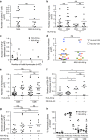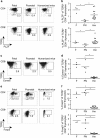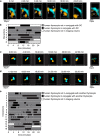Conserved and divergent aspects of human T-cell development and migration in humanized mice
- PMID: 25744551
- PMCID: PMC4575952
- DOI: 10.1038/icb.2015.38
Conserved and divergent aspects of human T-cell development and migration in humanized mice
Abstract
Humanized mice represent an important model to study the development and function of the human immune system. While it is known that mouse thymic stromal cells can support human T-cell development, the extent of interspecies cross-talk and the degree to which these systems recapitulate normal human T-cell development remain unclear. To address these questions, we compared conventional and non-conventional T-cell development in a neonatal chimera humanized mouse model with that seen in human fetal and neonatal thymus samples, and also examined the impact of a human HLA-A2 transgene expressed by the mouse stroma. Given that dynamic migration and cell-cell interactions are essential for T-cell differentiation, we also studied the intrathymic migration pattern of human thymocytes developing in a murine thymic environment. We found that both conventional T-cell development and intra-thymic migration patterns in humanized mice closely resemble human thymopoiesis. Additionally, we show that developing human thymocytes engage in short, serial interactions with other human hematopoietic-derived cells. However, non-conventional T-cell differentiation in humanized mice differed from both fetal and neonatal human thymopoiesis, including a marked deficiency of Foxp3(+) T-cell development. These data suggest that although the murine thymic microenvironment can support a number of aspects of human T-cell development, important differences remain, and additional human-specific factors may be required.
Figures




References
-
- 2Traggiai E, Chicha L, Mazzucchelli L, Bronz L, Piffaretti JC, Lanzavecchia A et al. Development of a human adaptive immune system in cord blood cell-transplanted mice. Science 2004; 304: 104–107. - PubMed
-
- 3Brehm MA, Cuthbert A, Yang C, Miller DM, DiIorio P, Laning J et al. Parameters for establishing humanized mouse models to study human immunity: analysis of human hematopoietic stem cell engraftment in three immunodeficient strains of mice bearing the IL2rgamma(null) mutation. Clin Immunol 2010; 135: 84–98. - PMC - PubMed
-
- 4Lepus CM, Gibson TF, Gerber SA, Kawikova I, Szczepanik M, Hossain J et al. Comparison of human fetal liver, umbilical cord blood, and adult blood hematopoietic stem cell engraftment in NOD-scid/gammac-/-, Balb/c-Rag1-/-gammac-/-, and C.B-17-scid/bg immunodeficient mice. Hum Immunol 2009; 70: 790–802. - PMC - PubMed
Publication types
MeSH terms
Substances
Grants and funding
LinkOut - more resources
Full Text Sources
Other Literature Sources
Research Materials

